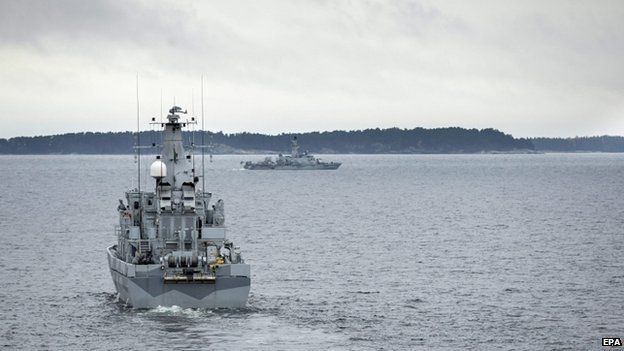What was lurking in Sweden's waters?
- Published

Sweden's armed forces say they have abandoned their search for what they believed was a submarine, spotted not far from Stockholm more than a week ago.
The hunt was described as Sweden's biggest mobilisation since the Cold War. Speculation had centred on Russia, but the Russians scoffed at the claims.
Was there a sub after all?
We may never know for sure. Initially, the Swedish military was careful not to state for certain what it was looking for, preferring to describe the mysterious submerged object as belonging to a "foreign power". But as the search went on, the Swedes were explicit: they were hunting a submarine.
Despite Russia's protestations, its navy was singled out as most likely. It has large submarines - 60m (197ft) or 70m class - as well as small. And the feeling was this one was probably small. There are two Russian mini-submarines that could fit the bill: the Piranha - seen as a diving submarine - and the Triton, used for research purposes.
Where was it spotted?
That is the great mystery. There were reported sightings in the southern Stockholm archipelago. But there are so many islands that defence officials said searching the area successfully was almost impossible.
The first photo appearing to show the submarine went viral and the armed forces asked for further help in finding it.
But they did not help matters when they deliberately gave out false information so as not to help a "foreign power".
When did it first show up?
Much of the detail is unconfirmed, but Swedish media say the first emergency signal was heard on 16 October, leading to reports of a damaged submarine
- A radio conversation in Russian was reportedly detected on Thursday 16 October between the Stockholm archipelago and the Russian enclave of Kaliningrad, where Russia's Baltic fleet is based
- A "man-made" object was then spotted in Kanholms Bay at around midday on Friday
- The military admitted late on Friday that something was up and that ships, planes and hundreds of people were involved in a search
- The search on Saturday centred on Kanholms Bay - an area of busy shipping lanes used by passenger ferries between Stockholm and the Latvian capital, Riga
- The first sighting captured on camera was released on Sunday
- By Monday, the military admitted it had given out a wrong location for the picture so as not to help a "foreign power"
- The military said late on Tuesday it was prepared to use force, hours after naval vessels scoured Ingaro Bay
- After days of working day and night, the navy said on Wednesday it was reducing the number of ships in the search but not "de-escalating" its efforts
- Those efforts were finally brought to a halt early on Friday 25 October
Was the search that big ?
Apparently it was Sweden's largest mobilisation since the Cold War. So many naval vessels were used that the scale of the night-and-day search had to be reduced because of exhaustion.
All manner of boats were used, including an M74 minesweeper, HMS Kullen, a stealth corvette, HMS Visby, and fast-assault craft. The Visby is equipped with sonar, a 57mm gun, and two ROVs (remotely operated vehicles) - one for underwater mine-hunting and the other for mine-disposal.
On Tuesday, Dagens Nyheter newspaper reported that an underwater ROV was being used in the search in Ingaro Bay.
Is any of this Cold War stuff plausible?
Russians have treated the allegations with disdain, even suggesting it might be a Dutch submarine. But the Ukraine crisis has revived many of the trappings of the Cold War. In the space of a couple of months
- Estonia has accused Russia of abducting a security official
- Finland has said Russian planes entered its airspace and one of its research boats was interfered with in international waters in the Baltic Sea
- Nato says a Russian spy plane briefly entered Estonian airspace on 21 October after flying near Denmark and Sweden
Sweden, like Finland, is not part of Nato but both have tightened their ties with the alliance. So the submarine hunt was seen in the context of a pact signed by Sweden and Finland on 5 September which enables joint training exercises and assistance from Nato troops in emergencies.
Many Swedes remember when a Russian sub loaded with nuclear torpedoes ran aground near a Swedish naval base in 1981.
What are the Russians doing about it?
Their initial response was a flat denial. "There have been no extraordinary, let alone emergency situations, involving Russian military vessels," the defence ministry in Moscow said on Sunday.
Some analysts in Moscow have queried whether the hunt is more about Swedish politics than Russian, and the Swedish military's need to justify higher military funding with the arrival of Prime Minister Stefan Lofven's centre-left government.
And it will not have gone unnoticed in Moscow that the day before the search was cancelled, the new government announced a larger than expected increase in Sweden's defence budget, focusing in particular on developing a new Gripen fighter plane. But the 3.1% increase for 2015 was less than the 4.3% rise given by the previous government for this year.
However, the Russian response could just have as well have been a bluff.
Why, for example, was a Russian-owned oil ship, NS Concord, circling just outside Swedish waters for hours on end? It is unclear, although the Swedish coastguard said its movements were not inconsistent with an oil tanker.
Then there was the involvement of another Russian ship, Professor Logachev, described as a research vessel specialising in studies on the ocean floor. Swedish media said it was seen heading towards the Swedish Baltic island of Gotland late on Tuesday night.
The reality is this mystery may never be solved.
- Published22 October 2014
- Published22 October 2014